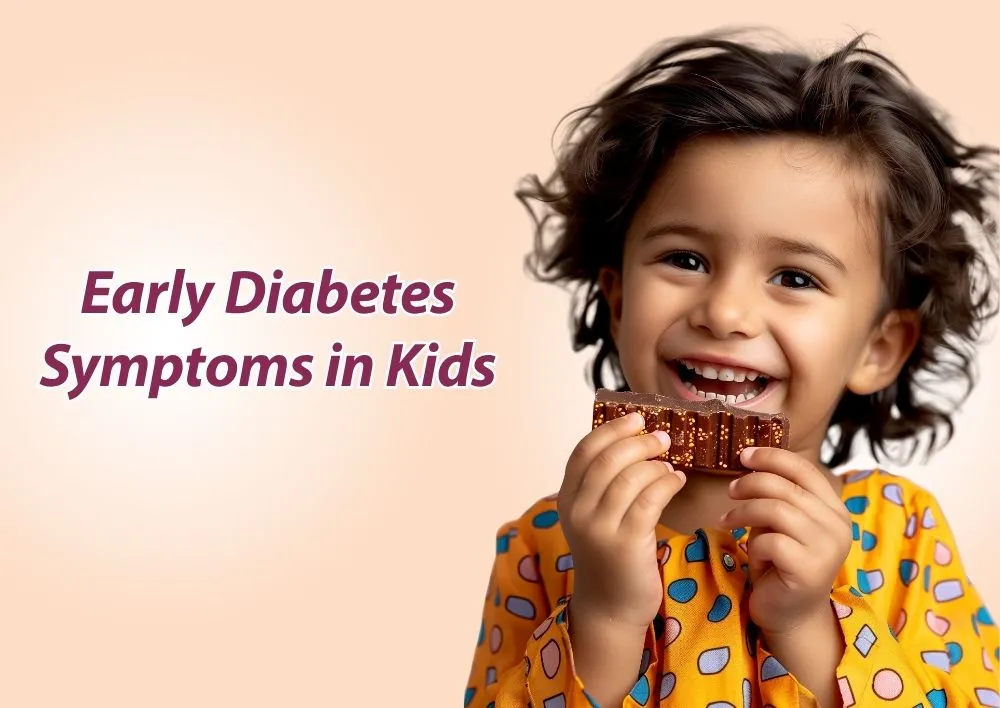Early Diabetes Symptoms in Kids: What Every Parent Should Watch For
Summary
Overview:
When we talk about diabetes, most people think it affects adults. But in reality, children can also develop diabetes, and the symptoms usually appear silently. As a parent, noticing the signs early can make a huge difference in your child’s long-term health, energy levels, and overall growth. If your child has been feeling more thirsty than usual, losing weight without trying, or visiting the washroom more often, these might not be “just a phase.” These can be early warning signs of diabetes.
In this blog, we will explore the most common diabetes symptoms in kids, why they happen, and when you should seek medical help.
Common Symptoms of Diabetes in Kids
Diabetes can show up in children through small changes that parents may easily ignore. But spotting these signs early can make a big difference in your child’s health and comfort. Here are some important symptoms you should never ignore:
1. Excessive Thirst
If your child keeps asking for water again and again, even right after drinking, it could be a sign that something is not right. Many parents initially think it is just a habit or warm weather, but sometimes it is the body trying to signal an underlying issue.
Why does it happen:
When blood sugar levels rise, the body starts pulling water from its tissues to dilute the extra sugar in the blood. This leads to increased thirst, and kids may ask for water more frequently throughout the day or even wake up at night feeling extremely thirsty.
According to Dr. Rahul Aggarwal, Senior Pediatrician in Gurgaon, Miracles Apollo Cradle, “Parents should never ignore excessive thirst in children, especially when it happens suddenly. It can be an early indicator of diabetes, and timely evaluation can help detect the condition before complications develop.”
2. Frequent Urination
Sudden bathroom breaks, both during the day and at night, are another common sign. Bedwetting may also return in children who were previously toilet-trained.
Reason:
The kidneys try to remove excess sugar from the bloodstream, leading to increased urination. It can become noticeable during school hours or bedtime.
3. Unexplained Weight Loss
A child who is eating normally but losing weight may be experiencing early symptoms of diabetes.
Why does it happen:
Without insulin, the body can’t use sugar for energy. It starts breaking down fat and muscle instead, leading to sudden weight loss. This sign is especially common in Type 1 diabetes.
4. Increased Hunger
If your child seems hungry all the time yet continues to lose weight, it may be a cause for concern.
Reason:
Because the body isn’t able to use glucose properly, it sends repeated hunger signals. This can lead to constant snacking or cravings, even after full meals.
5. Fatigue and Low Energy
Children are usually active and energetic, so constant tiredness or irritability can be an important warning sign.
Cause:
Without enough energy from glucose, kids may feel weak, sleepy, or unable to concentrate. They may seem less active than usual or become easily frustrated.
6. Slow-Healing Wounds & Skin Problems
If minor cuts, bruises, or scrapes take unusually long to heal, it may be related to high blood sugar levels.
Parents may also notice:
-
Dry, itchy skin
-
Frequent fungal or skin infections
-
Recurrent yeast infections in young girls
These can be early indicators that the body is struggling to manage sugar levels.
7. Blurred Vision
Children may complain about difficulty reading, seeing the board clearly, or focusing on objects.
Why:
High sugar levels can draw fluid away from the lenses in the eyes, causing temporary blurred vision.
8. Unusual Behaviour or Mood Swings
Sudden changes in mood or behaviour may also be connected to blood sugar fluctuations.
Kids may become:
-
Irritable
-
Moody
-
Easily frustrated
-
Less focused at school
Teachers may also notice changes in concentration or academic performance.
When Should Parents Be Concerned?
If you notice two or more of these symptoms, don’t wait.
Children with undiagnosed diabetes can quickly develop a serious condition called diabetic ketoacidosis (DKA), which requires immediate medical attention.
Seek help immediately if your child shows:
-
Vomiting
-
Fast breathing
-
Fruity-smelling breath
-
Severe tiredness
These can be emergency signs of Type 1 diabetes.
Diabetes Treatment in Kids
With modern treatments and proper guidance, children with diabetes can live completely normal and active lives.
Treatment includes:
-
Insulin therapy (for Type 1)
-
Oral medications (for Type 2)
-
Healthy diet plan
-
Regular physical activity
-
Monitoring blood sugar levels
Parents play an important role by offering emotional support and helping children build healthy habits.
Conclusion:
Diabetes in kids is more common than most parents realize, but it is manageable. The key is early recognition and timely medical care. If your child shows any of the warning signs mentioned above, don’t ignore them. A simple blood test can help protect their long-term health and well-being. If you notice any diabetes symptoms in your child or want expert guidance, schedule a consultation with a pediatrician near you today. Early care can make all the difference.
Frequently Asked Questions
Increased thirst, frequent urination, sudden weight loss, fatigue, and irritability are often the earliest signs.
Type 1 diabetes is an autoimmune condition where the child’s body stops producing insulin, requiring lifelong insulin support.
Ensure regular blood sugar monitoring, balanced meals, insulin management, and routine checkups while offering emotional support.
Doctors may perform a blood sugar test, an HbA1c test, and a urine test to check sugar levels and ketones.
No, type 1 diabetes is not caused by parents; it is an autoimmune condition that cannot be prevented or predicted.
Miracles Healthcare has a team of highly experienced pediatricians who are highly trusted for evaluating and managing diabetes in children.














Was the information useful?
0 0